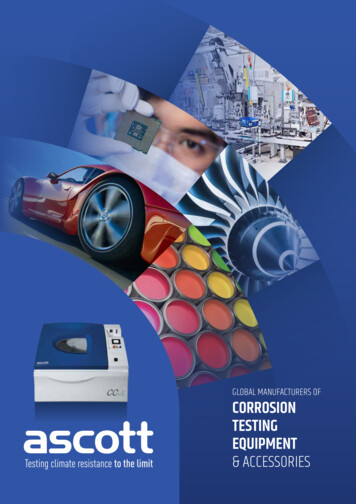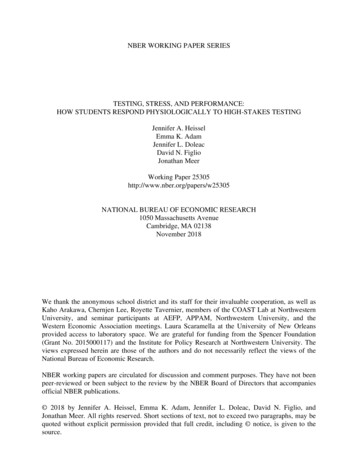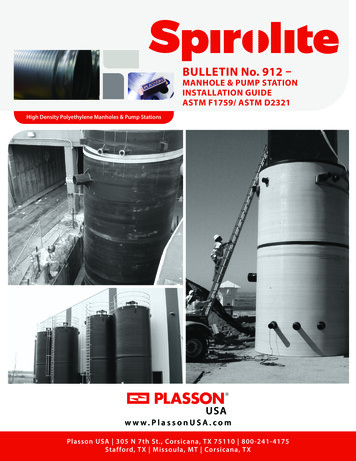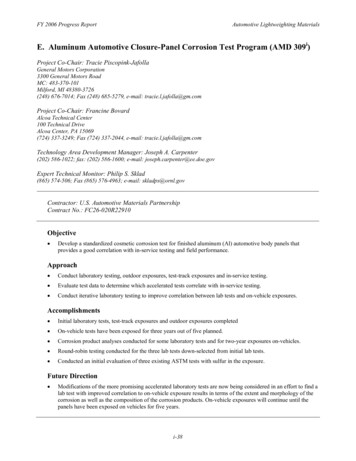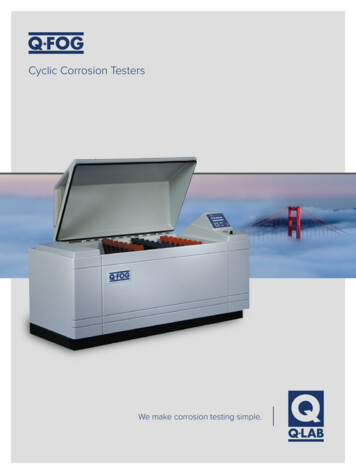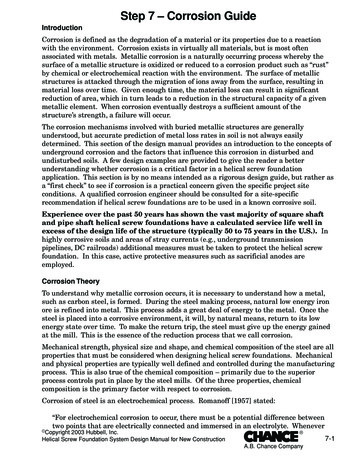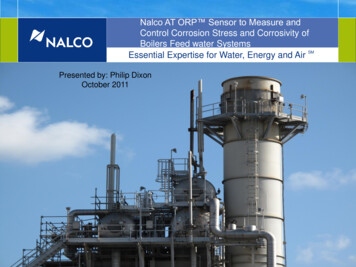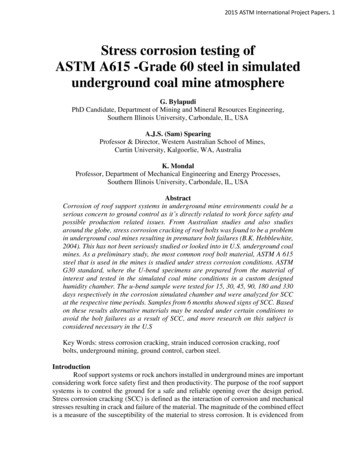
Transcription
2015 ASTM International Project Papers. 1Stress corrosion testing ofASTM A615 -Grade 60 steel in simulatedunderground coal mine atmosphereG. BylapudiPhD Candidate, Department of Mining and Mineral Resources Engineering,Southern Illinois University, Carbondale, IL, USAA.J.S. (Sam) SpearingProfessor & Director, Western Australian School of Mines,Curtin University, Kalgoorlie, WA, AustraliaK. MondalProfessor, Department of Mechanical Engineering and Energy Processes,Southern Illinois University, Carbondale, IL, USAAbstractCorrosion of roof support systems in underground mine environments could be aserious concern to ground control as it’s directly related to work force safety andpossible production related issues. From Australian studies and also studiesaround the globe, stress corrosion cracking of roof bolts was found to be a problemin underground coal mines resulting in premature bolt failures (B.K. Hebblewhite,2004). This has not been seriously studied or looked into in U.S. underground coalmines. As a preliminary study, the most common roof bolt material, ASTM A 615steel that is used in the mines is studied under stress corrosion conditions. ASTMG30 standard, where the U-bend specimens are prepared from the material ofinterest and tested in the simulated coal mine conditions in a custom designedhumidity chamber. The u-bend sample were tested for 15, 30, 45, 90, 180 and 330days respectively in the corrosion simulated chamber and were analyzed for SCCat the respective time periods. Samples from 6 months showed signs of SCC. Basedon these results alternative materials may be needed under certain conditions toavoid the bolt failures as a result of SCC, and more research on this subject isconsidered necessary in the U.SKey Words: stress corrosion cracking, strain induced corrosion cracking, roofbolts, underground mining, ground control, carbon steel.IntroductionRoof support systems or rock anchors installed in underground mines are importantconsidering work force safety first and then productivity. The purpose of the roof supportsystems is to control the ground for a safe and reliable opening over the design period.Stress corrosion cracking (SCC) is defined as the interaction of corrosion and mechanicalstresses resulting in crack and failure of the material. The magnitude of the combined effectis a measure of the susceptibility of the material to stress corrosion. It is evidenced from
2015 ASTM International Project Papers. 2several studies around the world, that the metal strength loss resulting from the combinedstress and corrosion is greater than the effects of stress and corrosion individually ("StressCorrosion Cracking," 2000; Z. Jian, 2007). Though corrosion may initiate and proceedwithout any assistance of stress just with corrosive agents, stress nevertheless plays a majorrole in accelerating the things in terms of material cracking and growth (P.H. Hieu, 2010).One of the main concerns with SCC is its latency without any signs of warning beforefailure (Jones, 1992).Several preliminary findings on rock bolt corrosion has been published in themining journals by Spearing and their research group at SIUC (A.J.S. Spearing, K. Mondal,G. Bylapudi., 2010). One of the major problems with this rock bolt corrosion is the stressesthey undergo in the environment (G. Bylapudi, 2015) and after careful considerationpreliminary experiments on stress corrosion of this steel has been studied as part of thisresearch, and the results are published in this paper.The research on ground control systems materials is limited in U.S.A even thoughone of its major industries is mining. According to NIOSH report, close to 68 million roofbolts were used by the mining industry in the year 2005 and the same was assumed as perother reports during 2014 (A.J.S. Spearing, G. Bylapudi, K. Mondal, A.W. Bhagwat., 2014;S.C. Tadolini, 2006). The results from this study will be of greatest interest to the miningindustry ground control professionals. The project results will lead to understand thesubject material’s ability to withstand SCC in the underground mine environment elsesuggest an alternate material to use.Material and EnvironmentOne of the common support systems used in the underground coal mines is steelrebars installed in the mine roof to avoid roof falls. The most commonly used material asthe rebars are ASTM A 615 steel and hence considered to investigate. The primaryobjective of this study is to evaluate the ASTM A 615 Grade 60 steel’s characteristics withrespect to stress corrosion in the underground coal mine simulated environment from theground water records collected from several mines (ASTM G30 is applied to achieve thisobjective). The ground water samples are simulated and introduced into the chamber on acirculating basis where the pH is being monitored on a regular basis and controlled to stayin the set range of 8.5, which is an average pH based on underground samples collectedfrom 13 mines (G. Bylapudi, 2014). In addition to the pH, several chemicals were addedto the water to simulate the underground aqueous atmosphere based on the records andconsidering the maximum assuming the worst case scenario, and the chemicalconcentration can be seen in the Table 1. The metallurgical data of the steel underinvestigation can be seen in Table 2. The secondary objective was to determine the materialloss of the steel due to corrosion in the simulated environment after 15, 30, 45, 90, 180 and330 days respectively (ASTM G1 is applied). The last objective of this study was todetermine if the hypothesis is true or not, i.e. whether stress corrosion cracking is a problemor not underground and at what time period that does this problem initiates in the simulatedenvironment. The testing was conducted in a custom designed corrosion chamber tosimulate the corrosive environment. The corrosion chamber designed for this purpose can
2015 ASTM International Project Papers. 3be seen in Figure 1 below with the test samples. The main purpose of this custom designedchamber was to add chemicals to simulate the humid environmentFigure 1. Custom designed humidity chamber used for the testing the U-Bend steelsamplesTable 1. Chemical concentration of the water in the O4Water Sample inLiters61.8634litersTable 2. Chemical composition of the .11Cr%0.11Mo%0.021Sn%0.010V%0.027Note: CEqvA706% 0.56Test ProtocolSince, all corrosion tests are site specific, the researcher undertaking these testsneeds to spend the majority of the time in analyzing the corrosive atmosphere from fieldstudies before simulating them in the lab.ASTM grade 60 steel rebar was taken and cut and then machined into severalrectangular strips as per the ASTM G30 standard. The machined test samples were bentclose to v shape and then stressed with the nut and bolt mechanism maintaining in aconstant strain conditions. To achieve this, two stage method was used. To avoid anygalvanic corrosion, teflon insulators were used separating the specimen of interest and nutbolt configuration. The Figure 2 shows the complete specimens before testing and Figure3 shows the sample specifications. Once the samples were prepared, in the final stage,surface preparation was performed by degreasing unwanted material or foreign objects.
2015 ASTM International Project Papers. 4Figure 2. U-Bend samples fabricated as per the ASTM G30 StandardFigure 3. Sample specifications
2015 ASTM International Project Papers. 5After the samples were prepared to the testing standard, the custom designedhumidity chamber was set with the desired atmospheric conditions as to simulate theunderground coal mine environment. As part of this testing the temperature was set to35 C throughout in order to accelerate the test process simulating the worst case scenario.From the historical water sample records that were collected from various coal mines, anaverage pH of 8.5 is set for the testing and maintained throughout the project. In additionto that, the water was prepared based on the worst case scenario with maximumconcentrations as per the records and the details were given in Table 1. All the sampleswere properly introduced into the chamber as to experience the humid environment similarto the underground. No samples were directly in contact with the water.The total number of samples that were prepared for this test are 19 in which 3samples were taken out of the chamber periodically and cleaned as per the procedure belowfor calculating the weight loss. An extra sample was used as a control sample forcalculating the weight loss of the base material when cleaned in the chemicals as per theASTM G1 standard. Reagent grade chemicals are used during the project from samplepreparation, during testing and finally at the time of cleaning corrosion test specimens. Forcleaning the corrosion specimens, reagent grade chemicals as mentioned in the C.3.5 fromASTM G1 cleaning procedures table has been applied, and the details can be seen in theTable 3.Table 3. Chemical solution used for cleaning corrosion specimensDesignationC.3.5MaterialIron andSteelSolution500 mL hydrochloric acid (sp. gr1.19)Time10minTemperature20 to 25 CRemarksLonger timesmay berequired3.5 g hexamethylene tetramineReagent water to make 1000 mLAfter successful cleaning at each period, the weight loss data was recorded andanalyzed. In addition to that, the samples were visually inspected for cracks, pits, etc. Laterthe samples were cleaned again via sonication using a sonicator for removing any unwantedmaterials and then inspected under a light microscope and then a scanning electronmicroscope for identifying the stress corrosion cracks, etc.ResultsAfter successfully corrosion testing for the desired intervals of time and cleaning,the following results are obtained. The ideal cleaning procedure of the corrosion samplesshould remove the corrosion products, with minimum impact on the base metal removalduring the chemical cleaning method used in this testing, yet a reference control samplewas used for making necessary corrections to avoid base metal loss. The control samplebase metal loss after 4 and 8 cycles of chemical cleaning is 0.03 and 0.05 gramsrespectively. The corrosion test samples from the chamber are first mechanically cleanedby scraping the corrosion products before chemical cleaning. The chemical cleaningprocedure was performed on the samples several times and the mass loss was determinedand recorded as WL1, WL2 and so on until WL8, where the number represent the cleaningcycle. The mass loss was graphed as a function of the number of cleaning cycles as shown
2015 ASTM International Project Papers. 6in the Figure 4. The material loss at a cycle where the data in the plot starts and stays almostparallel to the x – axis will be considered as the corrosion of the metal after removal ofcorrosion products. For 15, 30, 45, 90 and 180 day samples, fourth cleaning cycle, i.e., datafrom WL4 was determined to be the mass loss of metal due to corrosion whilst for 330samples, eight cleaning cycle, data from WL8 was determined to be the mass loss.The final mass loss data due to corrosion was determined for each sample atrespective time period and the results are recorded as shown in theTable 4 for further analysis and for future reference. Mass loss data from sample 1 of 180days was considered to be an outlier from professional judgement and hence ruled out fromthe data analysis. The graph from Figure 5 was plotted based on the obtained mass lossdata and from the trend line it was evident that the mass loss due to corrosion is incrementalwith respect to time. The R-squared value of the trend line, which is 0.9464 also provesthat it is a good-fit of the line to the obtained data.Figure 4. Step wise weight loss measurement plots
2015 ASTM International Project Papers. 7Table 4. Weight loss dataSample.No123Mean15 days0.560.740.800.7030 days0.920.971.241.0445 days1.141.081.321.1890 days2.682.472.652.60180 days1.703.042.672.86330 days4.355.624.364.78After the samples are treated and the mass loss was recorded, the microstructuralchanges in the samples were evaluated using scanning electron microscopy (SEM).Scanning electron microscope was used to determine the cracks due to stress corrosionafter each time period. Samples from 15, 30, 45, and 90 showed no signs of cracking butthere were pits developed at several locations. Samples from 180 days showed signs ofSCC that can be seen in the Figure 6. The samples form 330 days are corroded very badlyand the sample characterization showed no SCC as the cracks might have propagated intopits with time. Similar work with different grades and coatings in the future will result inmore information for solid conclusions. Overall, this preliminary study resulted in somevaluable information.Figure 5. Weight loss data with respect to time
2015 ASTM International Project Papers. 8500 µm10 µmFigure 6. SEM Image of the sample with SCCConclusionsThis stress corrosion testing proves to be a valuable and inexpensive methodologyto identify the materials ability to perform in the simulated mine atmospheric condition.Similar tests in the future with different material grades, coatings will lead to better materialselection for the specific conditions underground. Since, corrosion tests are site specific,the results vary from one location to other. SCC was not observed in the 15, 30, 45 and 90days’ test samples. SCC was observed in 180 days’ samples and the samples from 330days’ test set show advanced pitting resulting from crack enlargements. The weight lossof the test samples increased with respect to time for the designed test period.ReferencesA.J.S. Spearing, G. B., K. Mondal, A.W. Bhagwat. (2014). Rock anchor corrsion potentialdetermination in US underground coal mines. Paper presented at the 6th SouthAfrican Rock Engineering Symposium, Misty Hills, Muldersdrift
mines. As a preliminary study, the most common roof bolt material, ASTM A 615 steel that is used in the mines is studied under stress corrosion conditions. ASTM G30 standard, where the U-bend specimens are prepared from the material of interest and tested in the simulated coal mine conditions in a custom designed humidity chamber. The u-bend sample were tested for 15, 30, 45, 90, 180 and 330
